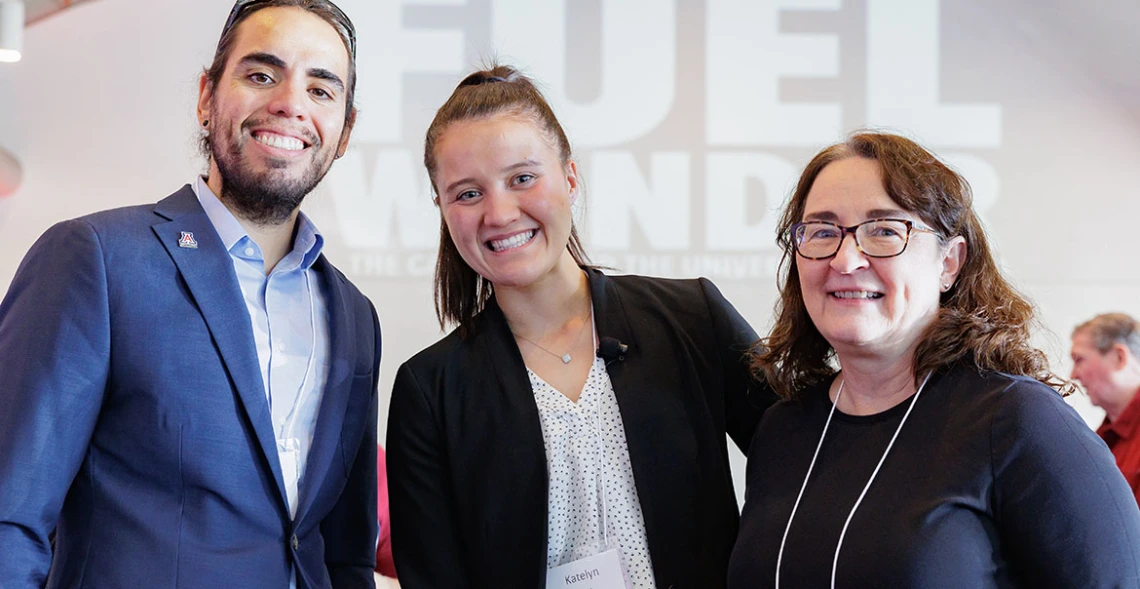Engineering and Supporters Kick Off Fuel Wonder Campaign
Alumni and friends are helping the college lead the way in education and innovative problem-solving.

Engineering alumni Christopher Stemple and Marla Peterson stand to the left and right of master of ceremonies and mechanical engineering student Katelyn Rees at the college’s Fuel Wonder launch event.
“Philanthropy is making a difference in the College of Engineering.”
This was the message from senior undergraduate Katelyn Rees, who served as master of ceremonies at The Future of Engineering, the December 2023 kickoff for the college’s participation in the University of Arizona’s Fuel Wonder fundraising campaign.
The theme continued to come through loud and clear as college leaders delivered presentations and participated in a panel discussion about the future of UA Engineering teaching, research and design to an audience of more than 80 supporters at the Clayton House in Scottsdale, Arizona.
The university launched the silent phase of the $3 billion Fuel Wonder campaign in 2017 and has raised more than $2 billion. The campaign’s public phase began at Homecoming 2023. During the silent phase, the College of Engineering raised more than $85 million toward its $100 million Fuel Wonder goal.
Support to Change the World
Priorities for the university and college include providing a holistic student experience for future leaders like Rees, who is a student regent for the Arizona Board of Regents, the governing board for the state’s three public universities.
Rees, who is double majoring in mechanical engineering and computer science, said engineering means “solving big problems, thinking critically, and being a world changer.”
“The College of Engineering has prepared me to do this by challenging me in my classes, surrounding me with peers accomplishing feats in research and in their careers, and giving me the support and resources to thrive,” she said.
Rees introduced faculty presenters Larry Head, director of the college’s Craig M. Berge Design Program; Mario Romero-Ortega, department head of biomedical engineering; and Kray Luxbacher, department head of mining and geological engineering and the Gregory H. and Lisa S. Boyce Leadership Chair of Mining and Geological Engineering.
Wonder in Mining, Medicine and Education
Luxbacher’s position is one of 11 current Engineering endowed faculty chairs, professorships and leadership chairs established by college supporters. Endowed professorships are a campaign priority, as they help the college attract and retain renowned faculty members.
Luxbacher shared her expertise on the world’s soaring need for mineral resources and how the UA is helping to meet challenges around extraction, refinement and geopolitical issues.
“We look to the future, and Arizona leads the way,” Luxbacher said.
Romero-Ortega spoke about another daunting challenge with which the UA is making strides, thanks to the help of its supporters – moving from medicine 2.0 to 3.0. This shift takes health care’s focus from the treatment of advanced disease to prevention and early disease detection and intervention.
“Imagine being able to detect one single cancer cell in your body at the start of the disease and treating it at that point – not when the tumor is fully formed or has metastasized,” he said.
The college is working with collaborators across campus on the Cancer Engineering Initiative, which has attracted funding from the state and donors including alumni Mike and Sheri Hummel.
Larry Head updated guests on plans for the upcoming Student Design and Innovation Center, a top campaign priority that has found support from many donors, including David Allais and the Thomas R. Brown Family Foundation. Within the next few years, the SDIC will provide collaborative classrooms and an advising center, a home for student clubs and organizations, and building and design spaces for student projects. In the meantime, college leaders have opened the Engineering Design Center to provide a 24-hour makerspace for all students in the college.
The donor-supported Peter and Nancy Salter Biomedical Device Design Lab has demonstrated the success of this type of design space for teaching and learning.
David W. Hahn, who holds the endowed position of Craig M. Berge Dean of the college, concluded the Future of Engineering by acknowledging the role alumni and friends have played in Engineering’s growth and success: enrollment and research funding are up, and relationships with industry partners and government leaders are strong.
“Thank you for helping us grow into the college we are today,” he said. “With your support, we will continue to educate, innovate and flourish. The College of Engineering is indeed inspiring wonder.”

